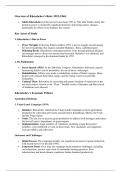Overview of Khrushchev's Rule (1953-1964)
• Nikita Khrushchev led the Soviet Union from 1953 to 1964 after Stalin's death. His
period in power is marked by significant domestic and foreign policy changes,
particularly his efforts to de-Stalinize the country.
Key Areas of Study
1. Khrushchev's Rise to Power
• Power Struggle: Following Stalin's death in 1953, a power struggle ensued among
the Soviet leadership. Key figures included Malenkov, Beria, and Khrushchev.
• Defeating Rivals: Khrushchev outmaneuvered his rivals through political alliances
and strategic moves. Beria was arrested and executed, Malenkov was sidelined, and
Khrushchev emerged as the dominant leader by 1955.
2. De-Stalinization
• Secret Speech (1956): At the 20th Party Congress, Khrushchev delivered a speech
denouncing Stalin’s cult of personality, his use of terror, and purges.
• Rehabilitation: Efforts were made to rehabilitate victims of Stalin’s purges. Many
people were released from labor camps, and the Gulag system was partially
dismantled.
• Cultural Thaw: Relaxation of censorship and greater freedom of expression in the
arts and sciences, known as the "Thaw." Notable works of literature and film critical
of Stalinism were allowed.
Khrushchev’s Economic Policies
Agricultural Reforms
1. Virgin Lands Campaign (1954)
• Initiative: Khrushchev launched the Virgin Lands Campaign to boost agricultural
production by cultivating previously unused land in Kazakhstan, Siberia, the Urals,
and the Volga region.
• Goals: The aim was to increase grain production to address food shortages and reduce
the Soviet Union’s dependence on grain imports.
• Implementation: Large numbers of volunteers, including young Komsomol
members, were mobilized to work on these lands. New machinery and equipment
were provided to aid cultivation.
Outcomes and Challenges:
• Initial Success: The campaign initially saw significant increases in grain production,
with record harvests in the mid-1950s.
• Long-term Issues: Over time, the campaign faced numerous challenges, including
soil exhaustion, erosion, and a lack of sustainable farming practices. Poor
infrastructure and harsh climatic conditions further hindered productivity.
, • Legacy: Although the campaign helped temporarily alleviate food shortages, it
ultimately highlighted the limitations of extensive, rather than intensive, agricultural
development.
2. Focus on Maize (Corn) Production
• Khrushchev’s Enthusiasm: Inspired by the success of maize in the United States,
Khrushchev promoted maize cultivation to improve livestock feed and increase meat
and dairy production.
• Campaign: Extensive propaganda efforts encouraged collective farms (kolkhozes)
and state farms (sovkhozes) to plant maize across the country.
Outcomes and Challenges:
• Mixed Results: While some regions experienced success, many areas were unsuitable
for maize, leading to poor yields and wasted resources.
• Agricultural Disruption: The focus on maize often came at the expense of other
essential crops, disrupting agricultural balance and causing further inefficiencies.
3. Agricultural Reorganization (1957)
• Sovnarkhozy System: Khrushchev decentralized agricultural administration,
transferring control from central ministries to regional economic councils
(sovnarkhozy).
• Objective: The goal was to increase local decision-making and efficiency in
agricultural production.
Outcomes and Challenges:
• Bureaucratic Confusion: The reorganization created confusion and inefficiencies
due to overlapping jurisdictions and lack of coordination.
• Limited Success: While intended to improve agricultural output, the decentralization
often led to fragmented management and inconsistent results.
Industrial Reforms
1. Decentralization of Industry (1957)
• Sovnarkhozy System: Similar to agriculture, Khrushchev decentralized industrial
administration by establishing regional economic councils to replace central
ministries.
• Objective: The aim was to reduce bureaucratic inefficiencies, promote regional
economic development, and better align production with local needs.
Outcomes and Challenges:
• Initial Enthusiasm: The policy was initially welcomed as a means to streamline
industrial management and foster innovation.




